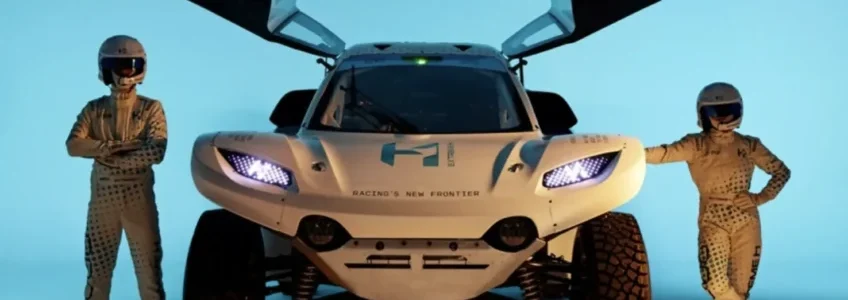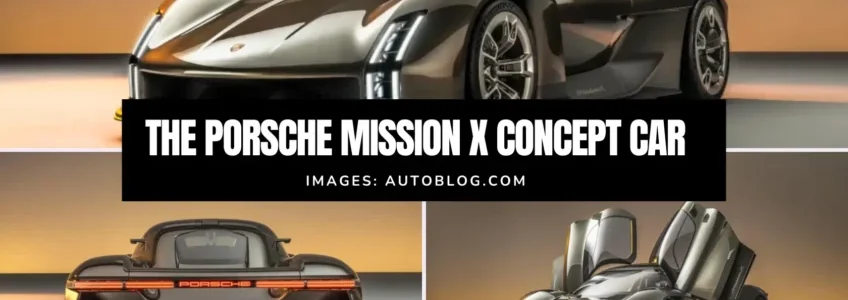Advanced lithium-ion batteries are at the forefront of revolutionising the electric vehicle (EV) industry, setting new benchmarks for range, durability, and sustainability. A recent breakthrough in battery technology has introduced a single crystal electrode design capable of withstanding over 20,000 charge-discharge cycles. This innovation translates to an astonishing five million miles of range in an EV, potentially outlasting the vehicle itself.
The automotive world has always been captivated by innovation, and the Lotus Theory 1 Concept, a futuristic electric sports car, pushes the boundaries of what electric vehicles (EVs) can achieve. Lotus, renowned for its lightweight sports cars, is introducing a bold new design concept that brings technology, performance, and sustainability together in a way that could shape the future of automotive engineering.
The automotive world is on the brink of a revolution, and hydrogen race cars are at the forefront of this transformation. As the motorsport industry increasingly looks for sustainable alternatives to traditional fuel, hydrogen cars are fast becoming the game-changing solution. This article explores how hydrogen race cars work, their benefits, and the role they could play in the future of motorsport.
The Imperative of Sustainability in Manufacturing
In the ever-evolving landscape of the automotive industry, the push towards sustainable automotive manufacturing has become more than a mere trend – it’s an imperative. As a leading UK engineering company providing precision engineering and custom fabrication across diverse sectors such as construction, rail, automotive, aerospace, defence, and oil and gas, we recognise the critical role of sustainability in manufacturing. The shift towards eco-friendly practices isn’t just beneficial for the environment; it’s a strategic move that aligns with the global call for responsible manufacturing.
Eco-Friendly Materials: The Building Blocks of Sustainable Automotive Manufacturing
The cornerstone of sustainable automotive manufacturing lies in the use of eco-friendly materials. Traditional materials, while effective, often carry a heavy environmental cost. Innovations in material science have paved the way for alternatives that offer the same, if not better, performance without the ecological downside.
Biodegradable plastics, recycled metals, and composites are becoming more prevalent, significantly reducing the carbon footprint of vehicles right from the production phase. Additionally, advancements in material technology have also led to the development of lightweight materials, which contribute to improved fuel efficiency and reduced emissions.
Aside from using eco-friendly materials, implementing renewable energy sources in sustainable automotive manufacturing facilities is another step towards sustainable practices. Solar panels, wind turbines, and hydroelectricity are examples of clean energy sources that can power the production process, reducing reliance on non-renewable resources. Not only does this reduce the carbon footprint of manufacturing facilities, but it also helps to mitigate the impact of rising energy costs.
Energy-Efficient Production Processes: The Heartbeat of Sustainability
Energy efficiency in manufacturing processes isn’t just about cutting costs; it’s about reducing our carbon footprint. Our commitment to sustainable automotive manufacturing is evident in our adoption of energy-efficient practices. These include utilising renewable energy sources, optimising production lines for minimal energy consumption, and implementing smart technologies that manage energy use more effectively. This shift not only aligns with sustainability in manufacturing but also sets a new standard for the industry.
What about the role of automation? Well, automation has been a game changer in automotive manufacturing, offering increased efficiency and precision while reducing labour costs. However, it also plays a crucial role in sustainable practices. The use of robots and other automated systems results in minimal waste production, as processes become more streamlined and precise. This not only reduces the environmental impact but also improves overall efficiency.
Collaboration: A Key Component for Sustainable Automotive Manufacturing
Achieving sustainability in automotive manufacturing requires collaboration between manufacturers, suppliers, and governing bodies. Collaborative efforts in research and development, sharing of best practices, and implementing standards for sustainable manufacturing are vital to drive the industry towards a greener future. This also involves engaging with consumers and educating them on the importance of sustainable practices in the automotive sector.
The Circular Economy: A Sustainable Vision for the Automotive Sector
The concept of a circular economy is integral to sustainable automotive manufacturing. Moving away from the traditional linear model of ‘take-make-dispose’, the circular economy emphasises the importance of recycling and reusing materials. This approach not only minimises waste but also conserves resources, creating a more sustainable lifecycle for automotive products. By integrating circular economy principles, we’re not just manufacturing products; we’re creating a sustainable legacy.
The Road Ahead: Challenges and Opportunities
While the journey towards fully sustainable automotive manufacturing is complex, it’s a path filled with opportunities. Challenges such as cost, technological advancements, and consumer acceptance are being met with innovative solutions and a steadfast commitment to sustainability. In conclusion, sustainable automotive manufacturing is not just a buzzword; it’s a crucial paradigm shift in the automotive industry.
As a pioneering engineering company working within various sectors, including automotive, we love sharing interesting engineering news, technology updates and much more. You can find all of our articles on our engineering blog and more information about our wide range of services on the PRV Engineering website.
At PRV Engineering, we appreciate the intricate blend of engineering prowess and historical reverence in automotive design. The Nissan Rally Z Tribute stands as a prime example of this fusion, offering an exhilarating nod to the iconic 1971 Safari Rally champion. As engineers and car enthusiasts ourselves, we can’t help but admire the meticulous attention to detail and innovative engineering that has gone into creating this modern-day rally legend.
Porsche’s recent unveiling of the Mission X concept hypercar has sent ripples throughout the automotive world. This striking electric supercar concept serves as a testament to Porsche’s vision for the future. At first glance, it’s a jaw-dropping spectacle; delve a little deeper, and the details are simply out of this world. Let’s dive in!
The Cheetah: More Than Just a Mascot
Upon closer inspection, a sprinting cheetah emblem becomes apparent near the rear wheels. Porsche’s decision to incorporate this swift, lightweight animal serves as an emblematic nod to the design ethos of this incredible hypercar. It’s a continuation of an endearing Porsche design tradition – infusing models with animal symbols. Remember the Vision 357’s dinosaur, a homage to the past, and the wild boar representing the race-ready Mission R?

Motorsports Roots Run Deep
In every curve and corner, there’s a trace of motorsports. The Mission X’s design borrows heavily from iconic Porsche race cars, with cleverly incorporated tributes like the vertical headlights reminiscent of prototype hypercars. The “Daytona” window harks back to the classic Porsche 917. Additionally, the inclusion of a passenger-side screen and clock, which can even be detached, screams ‘rally’ to any enthusiast.
Unconventional Braking at the Driver’s Fingertips
The steering wheel’s paddles have left many guessing. While most associated these with shifting, the real functionality was a delightful surprise. While the left paddle adjusts regenerative braking, the right one fine-tunes the brake balance. An intriguing and innovative feature that offers the driver unparalleled control.
Also Read: The Evolution and Prospects of the Automotive Industry
Track Ready, Yet Luxuriously Crafted Hypercar
Though the Mission X isn’t a full-fledged race car, it’s undeniably track-ready. Its luxurious metallic grey finish subtly contrasts its race ambitions. Thoughtful design elements like infotainment buttons crafted for ease of use, even with racing gloves on, and the bespoke seats – essentially modular pads that can be customised – reiterate Porsche’s attention to detail.
One might question the mid-engine design of an electric car. However, Porsche’s rationale is simple. The car’s battery pack sits snugly behind the seats, somewhat shaping its profile. Plus, let’s admit it, the mid-engine silhouette is a real classic.
What Lies Ahead For Porsche’s Hypercar Future?
While Porsche CEO, Oliver Blume, has hinted at the potential of a new hypercar, it won’t be before the decade’s end. Challenges with current battery technology remain a hurdle. However, the Mission X, not intended for sale currently, undoubtedly paints a tantalising picture of what the future might hold.
Adorning a unique Rocket Metallic with satin carbon fibre touches, the Mission X mirrors the dimensions of past legends like the Carrera GT and 918 Spyder. A blend of historic and contemporary design cues can be found, from the iconic illuminated DRLs to the futuristic lattice-supported LED taillights.
The car’s interior beckons speed enthusiasts, with its plush Andalusia Brown and Kalahari Gray upholstery, and the state-of-the-art “e-core” battery setup promises mid-engined dynamics.

The Porsche Mission X: Potential Record Breaker
Though specifics regarding drivetrain and output were conspicuously absent at the reveal, one thing’s for sure – if it goes into production, Porsche aims for the Mission X to be a Nürburgring record-breaker with unrivalled charging capabilities. And while its commercial future remains undecided, we’re certain that this hypercar concept has already garnered a list of eager, deep-pocketed enthusiasts.
If the street-legal coupe goes to production, it would aim to “be the fastest road-legal vehicle around the Nürburgring Nordschleife; have a power-to-weight ratio of roughly one hp per 2.2 lbs.; achieve downforce values that are well in excess of those delivered by the current 911 GT3 RS; offer significantly improved charging performance with its 900-volt system architecture and charge roughly twice as quickly as the current Porsche frontrunner, the Taycan Turbo S.”
In the ever-evolving landscape of automotive engineering, Porsche’s Mission X hypercar concept stands as a beacon of innovation, performance, and design. A marvel that has undoubtedly set the stage for an electrifying future.
The automotive industry stands on the cusp of revolutionary change, spurred by technological advancements, changing consumer preferences, and environmental concerns. Through this lens, we aim to provide a profound exploration of where the automotive industry is headed and the multifaceted trends propelling it forward.
Automotive engineering is a hotbed of innovation, and precision machining is the driving force behind its constant evolution. From enhancing performance to improving safety, precision engineering plays a pivotal role in shaping the vehicles we know and love today. As a leading manufacturer in the UK, we specialise in various sectors, including automotive engineering, and in this blog, we will explore the remarkable impact of precision machining in the world of automotive engineering and how it continues to drive advancements while improving quality.












Recent Comments